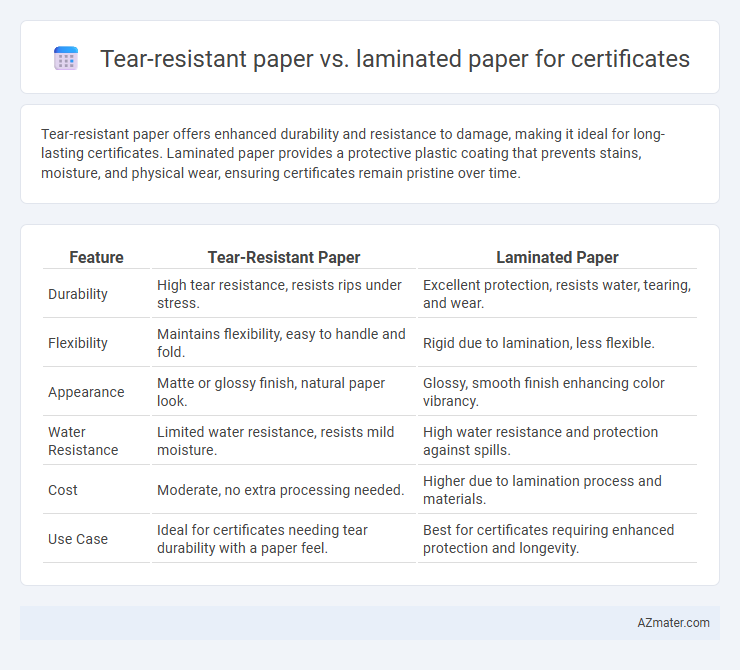Tear-resistant paper offers enhanced durability and resistance to damage, making it ideal for long-lasting certificates. Laminated paper provides a protective plastic coating that prevents stains, moisture, and physical wear, ensuring certificates remain pristine over time.
Table of Comparison
| Feature | Tear-Resistant Paper | Laminated Paper |
|---|---|---|
| Durability | High tear resistance, resists rips under stress. | Excellent protection, resists water, tearing, and wear. |
| Flexibility | Maintains flexibility, easy to handle and fold. | Rigid due to lamination, less flexible. |
| Appearance | Matte or glossy finish, natural paper look. | Glossy, smooth finish enhancing color vibrancy. |
| Water Resistance | Limited water resistance, resists mild moisture. | High water resistance and protection against spills. |
| Cost | Moderate, no extra processing needed. | Higher due to lamination process and materials. |
| Use Case | Ideal for certificates needing tear durability with a paper feel. | Best for certificates requiring enhanced protection and longevity. |
Introduction to Certificate Durability Options
Tear-resistant paper offers enhanced durability through reinforced fibers that prevent rips and creases, making it ideal for certificates requiring long-term preservation. Laminated paper provides a protective plastic layer that shields certificates from moisture, stains, and physical damage, ensuring vibrant colors and text integrity over time. Both options significantly extend the lifespan of certificates, with tear-resistant paper favoring flexibility and laminated paper prioritizing waterproof protection.
What is Tear-Resistant Paper?
Tear-resistant paper is a specially engineered substrate designed to withstand ripping and tearing, making it ideal for certificates that require durability and longevity. Unlike laminated paper, which involves sealing the document with a plastic film to protect it from moisture and damage, tear-resistant paper incorporates synthetic fibers or reinforcement layers during production to enhance flexibility and strength. This type of paper ensures certificates maintain a professional appearance without the added bulk or glossiness of lamination, providing a resilient yet natural finish.
Understanding Laminated Paper
Laminated paper used for certificates involves a protective plastic film bonded to the paper's surface, enhancing durability, water resistance, and overall longevity. This lamination safeguards printed information from smudging and physical damage, making it ideal for documents that require frequent handling or display. Unlike tear-resistant paper, which relies on specialized fibers for strength, laminated certificates achieve superior protection through an added layer, preserving the certificate's integrity over time.
Key Differences Between Tear-Resistant and Laminated Paper
Tear-resistant paper is specially engineered with reinforced fibers to prevent rips and ensure durability without altering the paper's natural texture, making it ideal for certificates requiring frequent handling. Laminated paper involves sealing the document between plastic layers, offering superior protection against moisture, stains, and physical damage while enhancing rigidity but sacrificing the original paper feel. The key differences lie in durability versus texture preservation, with tear-resistant paper maintaining a traditional finish and laminated paper providing a glossy, waterproof shield.
Durability and Longevity Comparison
Tear-resistant paper offers enhanced durability due to its strong fiber composition, reducing the risk of rips and damage during handling, making it ideal for certificates requiring frequent display or transport. Laminated paper provides superior longevity by encapsulating the certificate in a plastic film, protecting it from moisture, stains, and UV exposure, which ensures preservation over extended periods. Comparing both, tear-resistant paper excels in physical resilience, while laminated paper delivers unmatched protection against environmental factors for long-term certificate preservation.
Appearance and Professional Finish
Tear-resistant paper offers a smooth, matte finish that exudes a subtle elegance ideal for formal certificates, while maintaining durability without compromising a professional look. Laminated paper provides a glossy, high-shine surface that enhances colors and text contrast, delivering a polished and vibrant appearance that resists smudges and wear. Both options ensure certificates appear distinguished and enduring, with tear-resistant paper favoring understated sophistication and laminated paper emphasizing a sleek, modern finish.
Environmental Impact: Eco-Friendly Alternatives
Tear-resistant paper used for certificates offers a biodegradable and recyclable option that reduces plastic waste compared to laminated paper, which often involves non-recyclable plastic films. Laminated certificates, while durable, contribute to environmental pollution due to their difficulty in recycling and tendency to persist in landfills. Choosing tear-resistant paper aligns with eco-friendly practices by minimizing plastic use and promoting sustainable disposal methods.
Cost Analysis: Which is More Economical?
Tear-resistant paper typically costs more upfront due to its specialized fibers and durability, making it a one-time investment for certificates requiring long-term preservation. Laminated paper involves lower initial paper costs but adds additional expenses for lamination processes, equipment, or outsourcing, increasing the per-unit cost especially for high volumes. Evaluating total expenditure, tear-resistant paper is more economical for frequent handling certificates, while laminated paper suits occasional use where enhanced surface protection is necessary.
Applications and Best Use Cases
Tear-resistant paper is ideal for certificates frequently handled or displayed in high-traffic environments, such as schools and corporate offices, where durability without added bulk is essential. Laminated paper offers superior protection against moisture, dirt, and physical damage, making it best suited for certificates that require long-term preservation or outdoor display. Selecting tear-resistant paper supports easy signing and framing, while laminated certificates excel in preventing wear and maintaining a pristine appearance over time.
Choosing the Right Paper for Your Certificates
Tear-resistant paper offers durability and resistance to damage, making it ideal for certificates that require long-lasting quality without added layers. Laminated paper provides enhanced protection through a plastic coating, guarding against moisture, dirt, and physical wear while giving the certificate a polished finish. Selecting the right paper depends on balancing the need for durability, aesthetic appeal, and protection against environmental factors specific to the certificate's intended use and display conditions.

Infographic: Tear-resistant paper vs Laminated paper for Certificate
 azmater.com
azmater.com